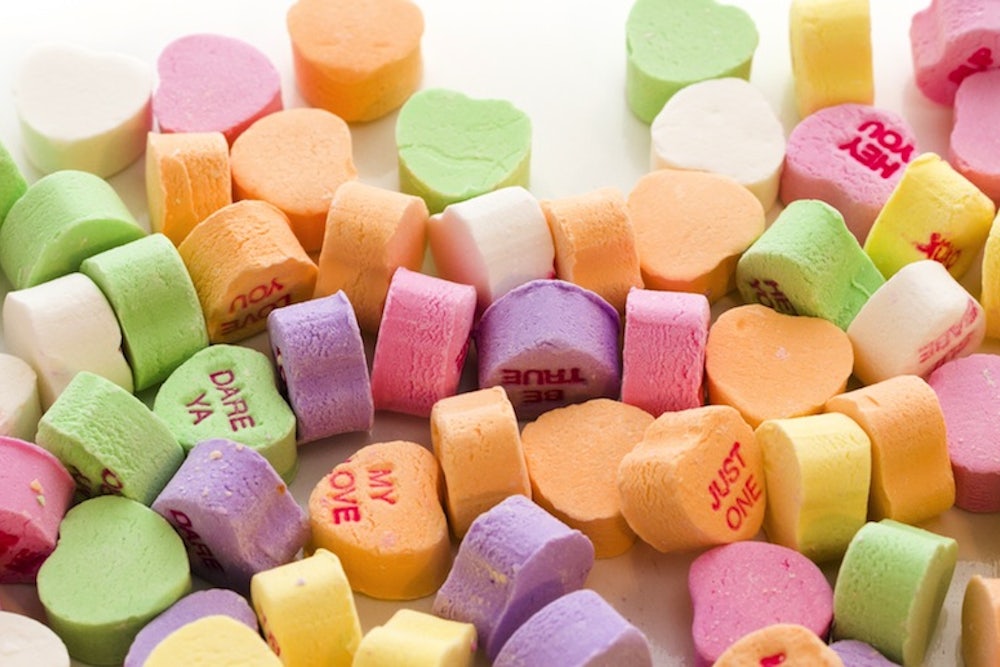The number of ways we have of addressing each other in an endearing way is probably quite limited. After all, what options are there once we have exhausted the three lexical stalwarts of this semantic field—darling, dear, and love? If the object of our affection is to be pleased with the term of address we use, there has to be a shared sense of the pleasurable; and judging by the items in the list below, very few areas of the lexicon qualify.
Taste seems to be the dominant motif. We see it also in the eatables that are adapted to terms of address: Cinnamon, powsowdie, sucket, bag-pudding, cabbage, pumpkin, sugar, and lamb-chop. These are the attested instances. Probably far more foodstuffs have an idiosyncratic or nonce usage than are recorded in OED pages. Some seem to be influenced by fashion: Types of fish, for example, were once attractive names, it would seem, judging by whiting, sparling, and prawn. This seems unlikely today, though evidence of my little codfish or suchlike would prove me wrong.
What is surprising is the absence of lexical fields we might expect to see, such as flowers (apart from daisy). Doubtless nonce-usages of daffodil, tulip, and the like occur, but evidently not with sufficient frequency to be caught within the lexicographer’s net. Appearance is likewise missing, apart from color in golpol, a reference to the eyes in nye and nykin, and some examples relating to size (pug, fub, pinkany). Behavior is conspicuous by its absence, apart from wanton.
A Selected Timeline of Terms of Endearment
sweetheart
1290
This combination of sweet ("lovely, charming, delightful") c. 1290 and heart (as the seat of the emotions) was originally written as two words, a practice that continued into the seventeenth century. It is traditionally used both for someone with whom one is in love and more generally for anyone with whom one has an affectionate relationship; but since the nineteenth century it has developed ironic or contemptuous slang uses, as seen in Frank Parrish’s novel, Fire in the Barley (1977): "Try harder, sweetheart, or I’ll plug you in the guts."
mopsy
1582
The word is probably an amelioration of mop in its sense of "fool." It was often used when talking to a child, especially a young girl, along with mops (1584) and moppet (1601), and moved from there to any woman, especially one of small stature. The name in this sense remained popular in northern and eastern dialects of England, and continues to turn up from time to time in present-day literature, though today it’s more likely to reflect a pejorative use ("a dowdy, dirty, or untidy woman") that developed in the seventeenth century. A witch in Harry Potter-world has the name of Mopsy.
bawcock
1601
This is a man-to-man endearment, "fine fellow, my good man," from French (beau coq—"fine cock’"). It was often used sarcastically, as when Sir Toby Belch teases Malvolio, calling him "my bawcock" (Shakespeare, Twelfth Night, c.1602, 3.4.112).
old thing
1625
An expression that has ameliorated with age. It was originally an expression of contempt or reproach aimed at anyone who was literally old, often found with demeaning adjectives (such as "ugly old thing," 1717). But in the nineteenth century we see it used with warmhearted adjectives (especially as "dear old thing," 1852), and eventually on its own as an affectionate form of address to a person of any age.
frisco
1652
The word seems to be a sixteenth-century pseudo-Italian formation, based on frisk, referring originally to a brisk dancing movement. As a term of address, it is recorded in a single OED citation from playwright Richard Brome’s The New Academy (1.1.3) "Where’s my Boykin? my Frisco? my Delight?"
acushla
1825
An Irishism (from a chuisle, "heartbeat"), used to mean "darling, dear"—the a being a particle that shows the noun is being used to address someone. In Virginia Brodine’s novel, Seed of the Fire (1996, ch. 13), about Irish immigrants in America, we read "Bridget, acushla, how is it with you?" The early nineteenth century also saw macushla (from mo chisle, "my heartbeat") used in the same way.
prawn
1895
The dominant human application of prawn was unflattering in 1895, but there is a single OED citation suggesting that, for some people at least, the noun could be an endearment. "I expect you’re a saucy young prawn, Emma," says a character in William Pett Ridge’s Minor Dialogues (1895).
sugar
1930
Given that sugar is recorded in English from the thirteenth century, and often used figuratively and proverbially since then, it’s surprising that the fashion to use the word as a term of address seems to be not much older than the 1930s. Among the more popular compound words since then are sugar-babe and sugar-pie, but a wide range of possibilities exists. A 2001 song by Woody Guthrie begins: "Tippy tap toe, my little sugar plum."
lamb-chop
1962
A woman in Ellis Lucia’s memoir, Klondike Kate (1962, ch. 2) is described as "quite a lamb chop." It strains my imagination to think of lamb chops being used for direct intimate address, but that’s one of the risks you take when you engage in thesaural lexicography.
Reprinted from WORDS IN TIME AND PLACE: Exploring Language Through the Historical Thesaurus of the Oxford English Dictionary by David Crystal with permission from Oxford University Press, Inc. Copyright © David Crystal 2014.
